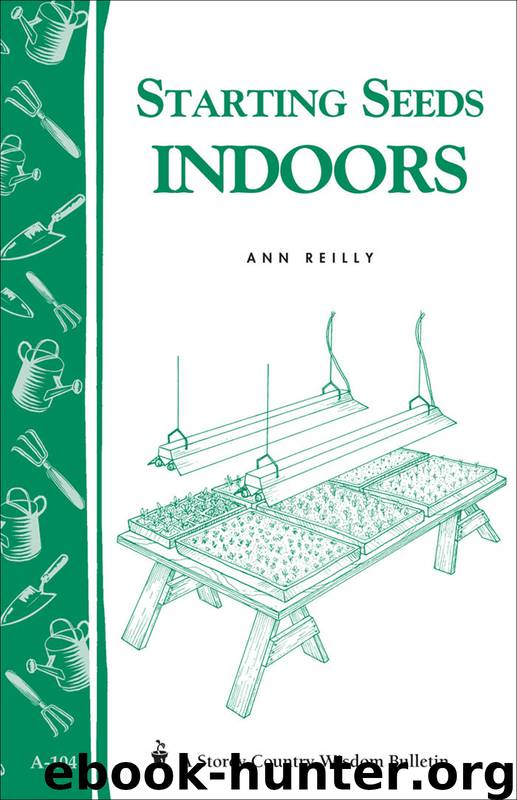Starting Seeds Indoors by Ann Reilly

Author:Ann Reilly
Language: eng
Format: epub
Publisher: Storey Publishing, LLC
Published: 1988-03-25T16:00:00+00:00
After You Germinate
After your seeds have germinated and the seedlings are growing strong and healthy, it’s time to plant them into the garden.
Planting into the Garden
Double-check planting dates before you start moving plants outside. Most annuals and vegetables must wait until danger of frost is past to be placed outside; some can go out earlier. Tomatoes, eggplant, and peppers should wait a little longer until the ground has completely warmed up.
Plan the garden in advance. Select plants for sun and shade, and check planting distances.
The soil must be well prepared in advance to get the most from your flowers, vegetables or herbs.
Before moving your plants into the garden, water both the ground outside and the transplants. This will cut down on transplanting shock. It’s preferable to do your transplanting on a cloudy day or late in the afternoon so the heat of the sun won’t cause excess wilting. If you’ve used individual peat pots or peat pellets, transplant shock and wilting will be held to a minimum.
Dig a hole about twice the size of the root ball. Set the transplant into the hole so the root ball will be covered by ¼ inch of soil, and press soil firmly about its roots so there is good contact between the soil and the roots.
Seedlings in peat pellets can be planted as they are. When planting a peat pot, peel whatever you can off the pot before planting so the walls of the pot will not confine the roots. Be sure the peat pot is completely covered with soil so it will not dry out and act as a wick, allowing moisture to escape from around the roots.
If your transplants have been growing in flats that are not compartmentalized, very carefully cut out a root ball with a knife or a trowel. If the transplants have been growing in individual plastic pots or flat compartments, turn them upside down and tap them on the bottom, and they will come out easily.
The newly-set-out plants may look a little sparse at first, but they will grow and fill in quickly, and you won’t want them to be overcrowded. Adequate spacing also cuts down on disease.
Water well immediately after transplanting and again every day for about a week until the plants are well established and growing. Some transplants may wilt at first, but misting them every day or shading them will help them to quickly revive.
From this point on, a few simple maintenance practices will ensure a successful garden and a lot of enjoyment.
Download
This site does not store any files on its server. We only index and link to content provided by other sites. Please contact the content providers to delete copyright contents if any and email us, we'll remove relevant links or contents immediately.
Turbulence by E. J. Noyes(7942)
The Thirst by Nesbo Jo(6832)
Gerald's Game by Stephen King(4584)
Be in a Treehouse by Pete Nelson(3954)
Marijuana Grower's Handbook by Ed Rosenthal(3623)
The Sprouting Book by Ann Wigmore(3546)
The Red Files by Lee Winter(3368)
The Remains of the Day by Kazuo Ishiguro(3296)
Sharp Objects: A Novel by Gillian Flynn(2958)
Christian (The Protectors Book 1) by L. Ann Marie(2656)
Organic Mushroom Farming and Mycoremediation by Tradd Cotter(2631)
The Culinary Herbal by Susan Belsinger(2433)
Stone Building by Kevin Gardner(2353)
The Starter Garden Handbook by Alice Mary Alvrez(2285)
Lilac Girls by Martha Hall Kelly(2258)
The Unlikely Pilgrimage of Harold Fry by Rachel Joyce(2222)
The Lean Farm Guide to Growing Vegetables: More In-Depth Lean Techniques for Efficient Organic Production by Ben Hartman(2099)
Urban Farming by Thomas Fox(2063)
Backyard Woodland by Josh VanBrakle(1896)
